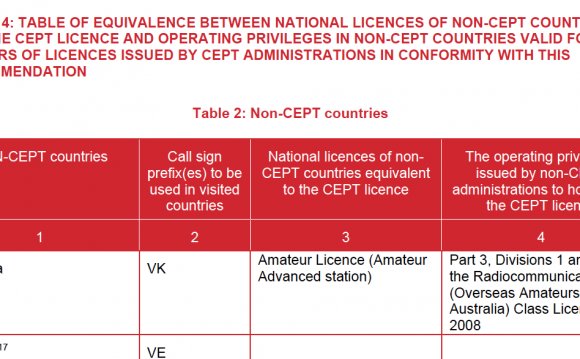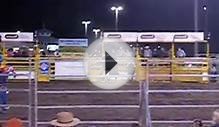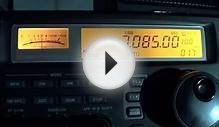
Dial from a transistorized mains operated Calstan radio, circa 1960s.
Call signs in Australia are allocated by the Australian Communications and Media Authority and are unique for each broadcast station. The use of callsigns on-air in both radio and television in Australia is optional, so many stations used other on-air identifications. Australian broadcast stations officially have the prefix VL- and originally all callsigns used that format, but since Australia has no nearby neighbors, this prefix is no longer used except in an international context.
Call sign blocks for telecommunication
The International Telecommunication Union has assigned Australia the following call sign blocks for all radio communication, broadcasting or transmission:
| Call sign block | |
|---|---|
| AXA–AXZ | Australia |
| VHA–VNZ | |
| VZA–VZZ |
While not directly related to call signs, the International Telecommunication Union (ITU) further has divided all countries assigned amateur radio prefixes into three regions; Australia is located in ITU Region 3. It is assigned ITU Zones 55, 58 and 59, with the Pacific Islands in Australian jurisdiction in Zone 60.
Australia is assigned CQ Zones 29 & 30.
Call signs for radio
All radio call signs begin with a single-digit number indicating the state or territory, followed by two or three letters. In most cases, two letters are used for AM stations and three for FM, but there are some exceptions, such as 5UV in Adelaide, which broadcasts on an FM frequency, and 3RPH in Melbourne, which broadcasts on an AM frequency. While some AM stations retained their old call signs when moving to FM, most add an extra letter to the call sign. For instance, when 7HO Hobart became an FM station, it adopted the callsign 7HHO.
Certain ABC radio stations, particularly outside of metropolitan areas, may use five-letter call signs for FM stations: xABCFM for ABC Classic FM, xABCRN for Radio National, and xABCRR for ABC Local Radio - the being the state number. Also, SBS FM radio stations use a five-letter call sign, xSBSFM. (Sydney and Melbourne's AM stations use 2EA and 3EA, meaning Ethnic Australia.)
There are a number of exceptions:
- For some time, two radio stations used the callsign 4CCC - a commercial station in Charleville and a community station in Warwick, both in Queensland. The Warwick station's call sign was later changed to 4SDB. In addition, a temporary community broadcaster, 4CCC Coral Coast Country Community Radio Inc, uses the name 4CCC, though it does not have a callsign.
- Rebel FM, The Breeze, and Flow FM, which have many transmitters in Regional and Remote Central and Eastern Australia, use the callsigns 4RBL, 4BRZ and 8SAT respectively, regardless of which state their transmitters are located in.
- Radio Station 1RPH Canberra, Australian Capital Territory has relay transmitters in New South Wales
- The following Victorian stations also have relay transmitters in New south Wales: 3HOT and 3RUM.
- The following New South Wales stations also have relay transmitters in Victoria: 2AAY, 2BDR and 2MOR.
- The following New South Wales stations also have relay transmitters in Queensland: 2MW and 2TEN.
- 8KIN Alice Springs, Northern Territory has a relay transmitter in Pasminco Century Mine, Queensland, and several in South Australia.
- 3MBR Murrayville, Victoria has a relay transmitter in Lameroo, South Australia.
- The Nhulumbuy, Northern Territory transmitter for triple J has the callsign 6JJJ.
- Open narrowcast radio stations have no official call sign, though some stations use one (e.g. 3XY Radio Hellas in Melbourne).
The following are lists of Australian radio station call signs.
Australian radios usually had the positions of radio stations marked on their dials (click the below (up to 1, 607 × 506 pixels) for a higher resolution view). This Calstan dial is from a mains operated transistorized radio, circa the 1960s.
There is an urban myth that call signs were based on Australian military districts but this incorrect as the following list of military districts show: 1 = Queensland; 2 = New South Wales; 3 = Victoria; 4 = South Australia; 5 = Western Australia; 6 = Tasmania; 7 = Northern Territory; 8 = New Guinea, and Papua.
Call sign assignments within Australia
The usual prefix for Australian amateur call signs is VK. The numeral that separates the prefix from the suffix indicates the state/territory in which the operator is licensed.
| Numeral | State/territory | |
|---|---|---|
| Antarctica | ||
| Australian Capital Territory | ||
| New South Wales | ||
| Victoria | ||
| Queensland | ||
| South Australia | ||
| Western Australia | ||
| Tasmania | ||
| Northern Territory | ||
| Australian External Territories | VK9C | Cocos Island |
| VK9N | Norfolk Island | |
| VK9W | World | |
| VK9X | Christmas Island | |
| VK9L | Lord Howe Island | |
| VK9M | Mellish Reef |
Since 1 Nov 2009 callsigns in the VK9 region have been treated the same as all other call areas, and individual islands are no longer designated by a special letter.
Operator class call signs
- Advanced Licences – indicated by the following structure: VK# xx, VK# Axx, VK# Bxx, VK# Cxx, VK# Dxx, VK# Exx, VK# Fxx, VK# Gxx, VK# Ixx, VK# Jxx, VK# Kxx, VK# Oxx, VK# Sxx, VK# Txx, VK# Uxx, VK# Wxx, VK# Xxx, VK# Yxx, VK# Zxx, VK# RAN, VK2RAS, VK# WIA–WIZ (WIA), VK# GGA–GGZ (Guides Aust), VK# SAA–SDZ (Scouts Assoc.), VK7OTC, VK# IYA–IYZ (International years)
- Standard Licences – VK# Hxx, VK# Lxx, VK# Mxx, VK# Nxx, VK# Pxx, VK# Vxx
- Foundation Licences – (four-letter suffixes beginning with 'F') VK# Fxxx
- Repeater call signs – VK# Rxx
- Beacon call signs – VK# RSx, VK# RTx
AX prefix
A special event prefix of 'AX' can be substituted for 'VK' on occasions of national significance (e.g. Sydney Olympic Games) and each year on Australia Day, Anzac day and World Information Society Day.
VI prefix
A special event prefix of 'VI' can be substituted for 'VK' on occasions of state/territory significance.
Overseas visiting amateurs
Visiting amateurs who qualify can use their home call sign, and attach a '/VK' after it. If a visiting amateur is issued an Australian call sign, they can combine both (e.g. VK1AAA/WA7AAA).
Call sign history
David Burger VK2CZ has written the definitive history of call sign allocation in the country.
Wireless experimenters were in most states by 1897, and the first list of call signs and licensees is from 1911. In 1912 the first system of a designated range for each state was issued by the PMG Department based on an XAA–XZZ block of letters. When all the three letter call signs were issued, provision was made to expand to four (e.g. XAAA). In 1914 a numeral was inserted after the 'X' to indicate the state (e.g. XAA became X1AA).
INTERESTING VIDEO












